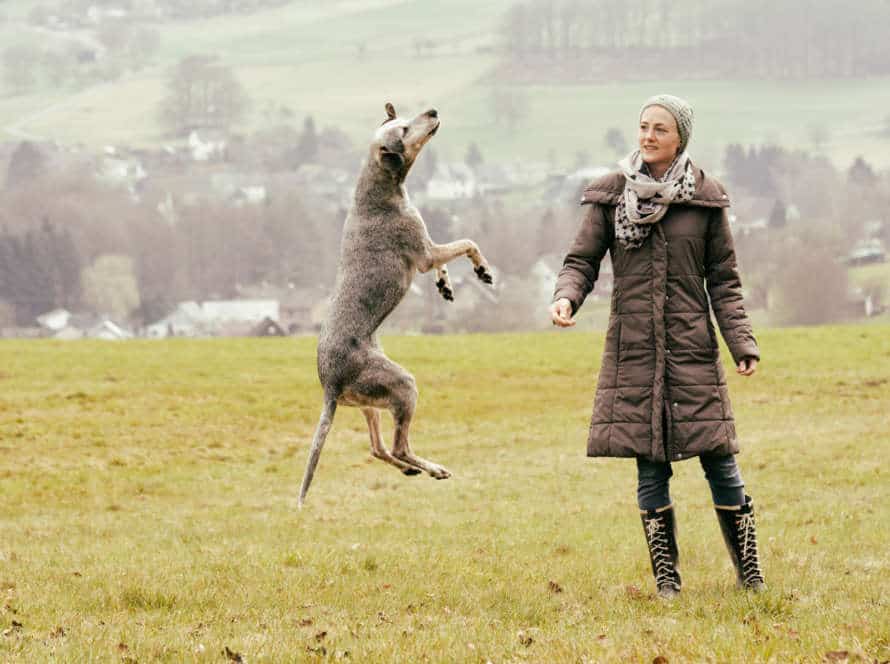Identifying Your Dog’s Barking Triggers: A Step-by-Step Guide
To control excessive barking and promote good behavior in your furry friend, it is essential to identify your dog’s barking triggers. Here’s a step-by-step guide to help you!
- Observe your dog’s behavior. Note the time, location and situation when he barks too much.
- Make a log of the triggers and how often he barks.
- Look for patterns and commonalities. Is it a sound? Or people or animals?
- Take steps to remove the triggers or control your dog’s response. E.g., if he barks at people outside the window, close the curtains or move him to another room.
By understanding your dog’s barking triggers and managing them, you can help your dog become calmer and better-behaved.
Understanding the Reasons for Barking in Dogs
Dogs barking can be a major disruption. To manage their behaviour, you need to understand the context behind why they are barking. There could be various triggers making your pup bark. A step-by-step guide can help you identify the cause and put an end to those noisy barks!
Communication and Alarm Barking
Dogs bark for two main reasons: communication and alarm. It’s important to recognize why they bark and identify the triggers.
Communication barking can be greetings, playfulness or requests for attention. Alarm barking is usually caused by perceived threats like strangers, other dogs or loud noises.
To figure out your dog’s triggers, observe what’s happening when they bark. Note the time, location and environment.
By understanding why they bark, you can respond properly and train them to stop excessive barking.
Territorial and Protective Barking
Territorial and protective barking are two common types of barking in dogs. Knowing why your dog is barking is key to training them.
Territorial barking is when dogs bark at strangers or unfamiliar sounds or movements. Like passing cars or people.
Protective barking is when they bark to protect their owners or themselves from danger or threats. It often includes aggressive behavior like growling and raised hackles.
Identifying your dog’s triggers is the first step. Reward them with treats and praise for appropriate barking behavior.
Desensitization exercises can help reduce their barking. This can improve your relationship and make for a calmer home environment.
Boredom or Attention-Seeking Barking
Barking is a normal part of being a dog, but too much barking could be a sign of boredom or wanting attention. To fix this issue, it’s important to understand why your pup barks. You can do this by:
- Watching when they bark.
- Noticing the context- What causes them to bark? A sound, smell or someone?
- Examining your pup’s body language when they bark- Are they scared, angry or happy?
- Rewarding good behavior and discouraging bad behavior- Give treats, cuddles or verbal cues to praise good behavior and discourage barking.
By understanding your dog’s barking, pet owners can live peacefully with their furry companions.
Step-by-Step Guide to Identify Your Dog’s Barking Triggers
Dogs bark for many reasons. Discovering the cause is essential. It helps reduce stress for both you and your pup. This guide helps you identify the triggers and manage them. Here’s how:
- Step-by-step: Identify the trigger.
- Provide tips to manage it.
Observe Your Dog’s Body Language and Environment
Observe your pup’s body language and environment carefully. It’s key to figuring out your dog’s barking triggers. Identify those triggers and take steps to resolve the underlying problem, and prevent too much barking.
Here are some tips:
- Keep an eye on your dog’s body language. Is it pacing, panting, or cowering? Signs of stress or anxiety?
- Analyse their environment. Anything that could be causing fear? Loud noises, people/animals they don’t know, changes in routine?
- Monitor their behavior. Does it bark a lot when you leave, or during certain activities like mealtime or playtime?
- Write down when and why it barks. That way you can spot patterns and tackle the issue more effectively.
By watching your pup’s body language and environment, you can get to the bottom of their barking triggers and take action.
Keep a Diary to Track Your Dog’s Barking
Create a diary to keep track of your pup’s barking. Note the date, time, and context of each barking episode. Look over the diary and find any patterns in their barking. What situations or activities make them bark? Analyze the context of the barking episodes. What is your pup trying to say? Fear? Boredom? Frustration? Make changes in the environment or routine to reduce or prevent barking triggers. Exercise more? Give interactive toys? Train to reduce fear or anxiety? Monitor and track the results of the changes.
Tracking your pup’s barking triggers in a diary can help you and your neighbors. It’ll also help you address any behavioral issues quickly.
Try to Replicate Situations That Trigger Your Dog’s Barking
Figuring out what triggers your pooch to bark can be tricky, but it’s key for cutting down excessive barking. Here is a step-by-step guide to help you:
- Keep a log of your pup’s barking habits. Note when, where, and how long they barked.
- Look for patterns in the notes. Does the barking happen at the same time? In the same place?
- “Re-create” the situation that causes barking. For example, if they bark at people by the house, have a friend walk by and observe.
- Pay attention to body language, warning signals, and changes in behaviour when the trigger occurs.
- Tackle the triggers with positive reinforcement training, and slowly get your pup used to them.
Pro Tip: Everyone should use the same method when training your dog. This will help reduce excessive barking.
Techniques to Address and Train Barking Behavior
Dogs barking? It’s likely due to stressors in the environment like strange animals, people, or events. To help your pup manage their barking, identify the underlying triggers. Then, use training techniques to make them stay quiet. We’ve got a guide to help you out. It’s step-by-step and shows you how to diagnose and tackle your pup’s barking triggers.
The guide includes:
- Identifying the underlying triggers of your dog’s barking
- Training techniques to manage and reduce barking
- How to use positive reinforcement to encourage good behavior
- Maintaining consistency in training
Positive Reinforcement Training with Treats and Verbal Cues
Positive reinforcement training is an effective way to tackle your pup’s barking. Utilize treats and verbal cues to reward good behavior. Here are some techniques to help you train your canine to stop yapping:
- Identify the triggers that cause your dog to bark.
- Use verbal cues like “quiet” or “enough” to signal your dog to be silent.
- Reward them with a treat or positive reinforcement when they stop barking after your cue.
- Be consistent in training and use positive reinforcement to encourage good behavior.
- Avoid punishing your dog for barking, as this can cause fear and anxiety. This can make the behavior worse.
Patience and practice will help your pup connect good behavior with rewards, resulting in a quieter and happier household.
Teaching “Quiet” Command and Rewarding Good Behavior
Two effective techniques for addressing and training your dog’s barking behavior are teaching the “Quiet” command and rewarding good behavior.
Step one is to identify your dog’s barking triggers. Is it the doorbell? Other dogs? Cars? Strangers?
Observe your pup’s behavior and find out.
Once you know what sets off the barking, expose your dog to the trigger in a controlled environment. Try a few seconds of a doorbell sound followed by a treat if they stay quiet.
Gradually increase the duration and intensity of the trigger and reward your pup when they remain calm.
Train them the “Quiet” command by giving them a treat when they stop barking on command.
Be patient, consistent, and positive with your training techniques.
Alternatives to Barking such as Interactive Toys and Chew Bones
Rather than your pup barking, interactive toys and chew bones can be a great solution! Here are some to consider:
- Puzzles! Stimulate your pup’s mind with these and help reduce stress and boredom.
- Kongs! Fill them with treats for a long-lasting chew.
- Rawhide bones! Satisfy their need to chew and occupy their time.
- Bully sticks! Made from dried bull or steer meat, they are tasty and help reduce anxiety and boredom.
Providing your pup with these alternatives can help them learn positive behavior and keep both their mind and body healthy.
Seeking Expert Advice for Chronic Barking Issues
Barking problem? Get professional help! A vet or animal behaviourist can help you understand your pup’s needs. They can offer tailored advice and tried-and-tested solutions to manage excessive barking. Let’s check out the possibilities!
Consult a Veterinarian for Medical Issues that Cause Barking
If your pup has chronic barking, it’s important to check with the vet to see if it’s a medical issue. Rule out medical causes, then identify triggers and change the behaviour. Here’s a guide:
- Watch your dog’s barking and note when, where, and why.
- Look for patterns – mealtime, someone at the door, other dogs.
- Once the triggers are known, expose them to those triggers in controlled settings.
- Use positive reinforcement to discourage barking and reward calmness.
Chronic barking can harm your pup and make your house noisy. Speak to a vet or animal behaviourist for help. Remember, consistency is key to training success. Be patient and stick to the routine!
Consider Professional Dog Trainers or Animal Behaviorists
Is your pup having chronic barking issues that can’t be solved with discipline? If so, speaking to an expert dog trainer or animal behaviorist could be beneficial!
Benefits of their expertise:
- These specialists can discover what is causing your pup to bark & customize a plan to address it.
- Plus, they can show you how to instruct your dog to communicate better & stop future barking.
So, if your pup’s barking is causing distress, disruption, or complaints from your neighbors or family, think about talking to a professional dog trainer or animal behaviorist for help.
Community Resources and Support for Barking Dogs
Dealing with a pup that barks too much? Don’t worry! There are many resources and support to help. For example:
- Animal shelters or rescue organizations may offer training and behavioural advice.
- Veterinary clinics can give medical advice, such as meds or treatments to help manage barking.
- Online forums and social media groups can connect you to other pet owners with similar issues.
- Professional trainers or animal behaviourists can give in-person or online consultations.
The first step is to identify why your dog is barking. Common reasons include boredom, anxiety, fear, or territory instincts. After that, you can work with a pro or use online resources to make a personalised training plan for your pup.
Frequently Asked Questions
What are common barking triggers for dogs?
Common barking triggers for dogs include unfamiliar noises, people or animals passing by, anxiety, boredom, or discomfort.
How can I identify what triggers my dog’s barking?
Observing your dog’s body language, identifying patterns, and noting the environment and context of the barking can help you identify what triggers your dog’s barking.
Is it possible to train my dog to stop barking?
Yes, it is possible to train your dog to stop barking through positive reinforcement training and addressing the root cause of the barking behavior.
Can a dog’s barking behavior be a sign of a health issue?
Yes, excessive barking can sometimes be a sign of a health issue such as pain, anxiety, or dementia. It is always recommended to consult with a veterinarian if your dog’s barking behavior is concerning.
How can I prevent my dog from barking when left alone?
Providing your dog with plenty of exercise, mental stimulation, and a comfortable space to rest can help prevent excessive barking when left alone. Additionally, desensitization training and leaving music or pheromone therapy can also be effective.
What should I do if my neighbor’s dog is constantly barking?
If your neighbor’s dog is constantly barking, it is recommended to talk to your neighbor in a respectful and polite manner. If the issue persists, contacting animal control or mediation services may also be an option.







